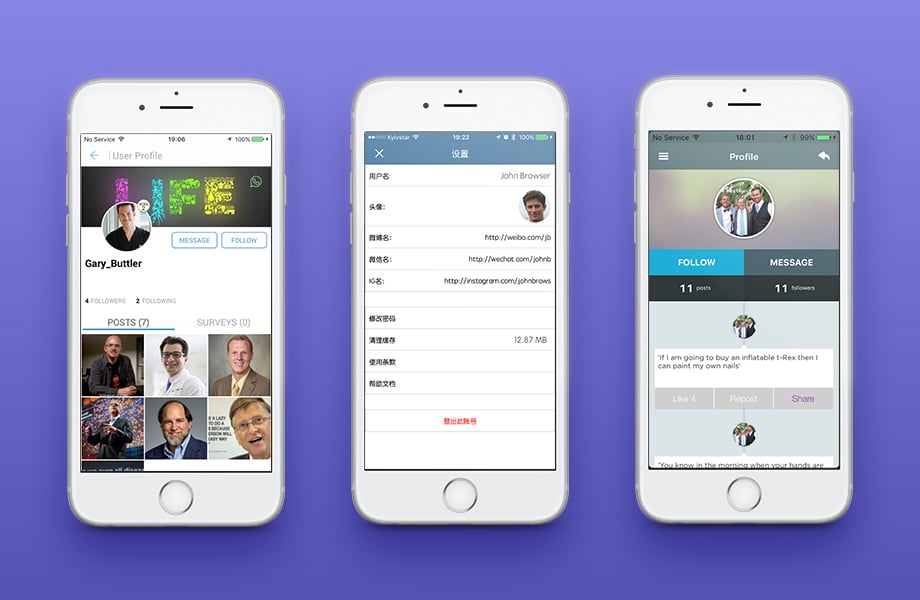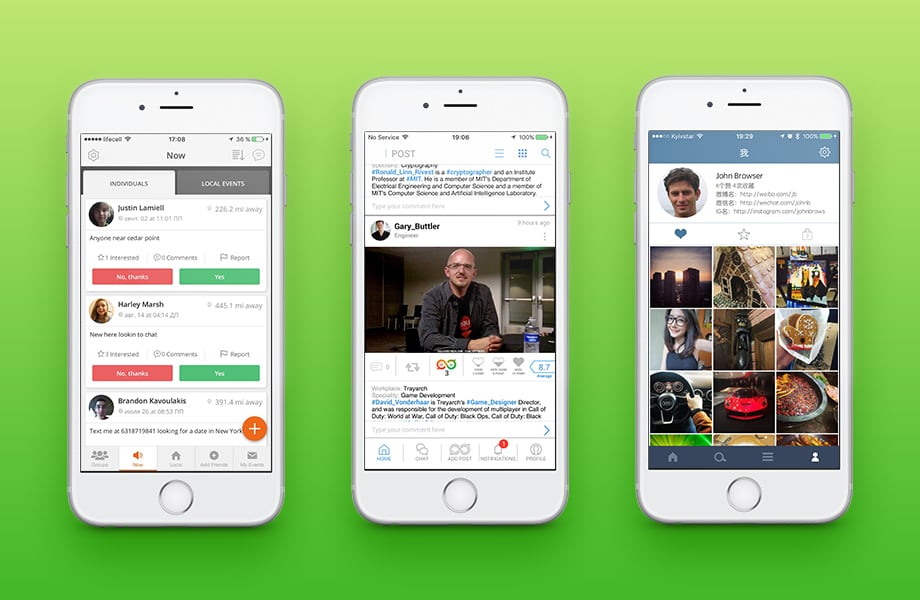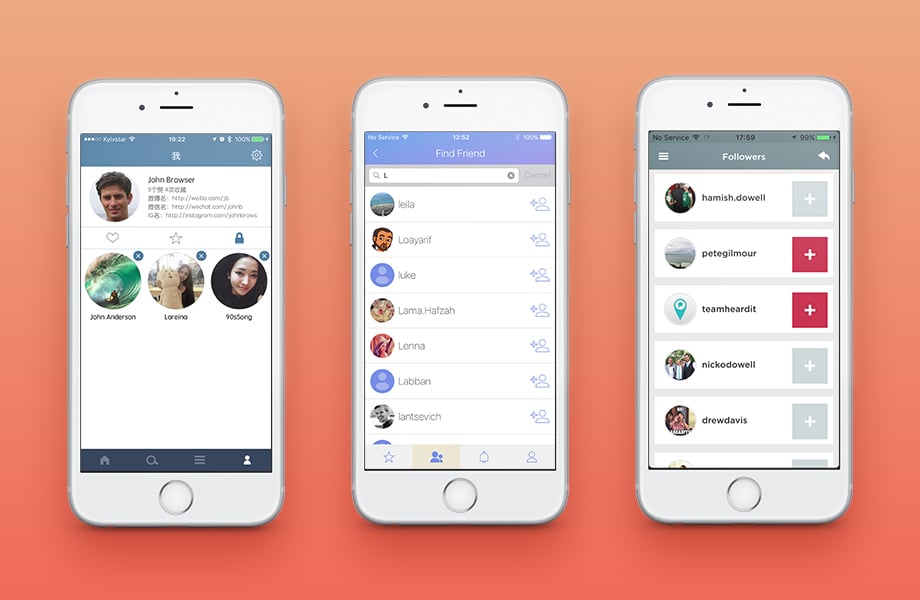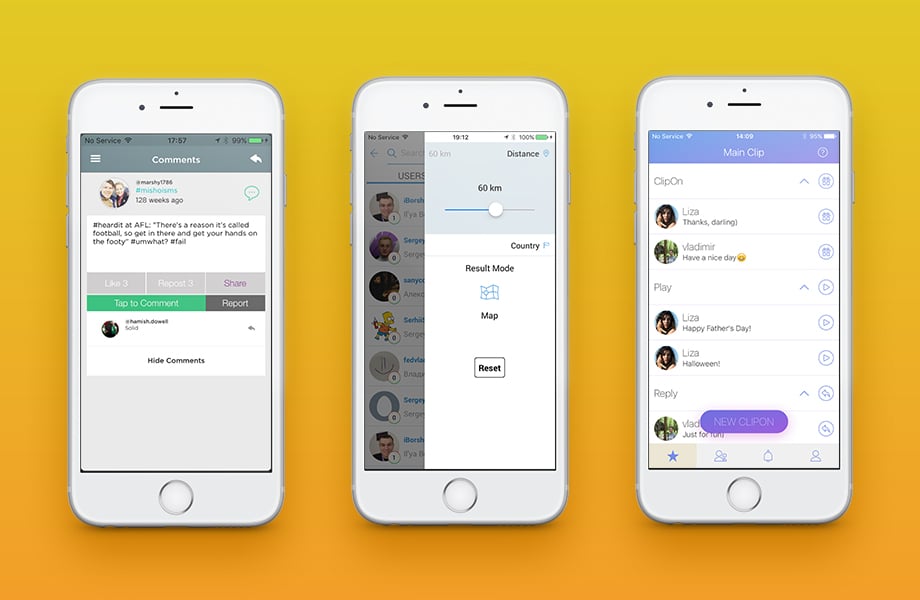By: Evgeniya Vi.
8 SEP 2017
1745
Nowadays, the social network niche remains one of the most promising, even though it is fairly tightly occupied by the dominant players. The rapid development of technology is providing more opportunities for the implementation of fresh ideas. This applies to social networks in general and social applications in particular as they determine the success of the project.
That is why developers continue to pay attention to this type of application. And that’s why advice on how to create a successful social application, as well as what characteristics it should have, remains relevant.
We would like to share with you our vision of what a good social application should be. And for clarity, we propose to conditionally divide social networks into several types, each with its own unique qualities and occupying different elevations:
-
Networks for communication that help people build personal, professional, business, etc., communications, for example, Facebook, and LinkedIn
-
Networks for multimedia exchange, for example, Instagram, Flickr, YouTube, Vine, Vimeo, Snapchat, and Quaner
-
Online reviews and feedback that help users make purchasing decisions, such as Yelp and KOOL
-
Forums and Q&A networks, where users exchange questions and answers, for example, Digg and Quora
-
Publishing platforms for publishing content, for example, Medium and Twitter
-
Social bookmarks to collect and organize information found on the Internet, for example, Flipboard and StumbleUpon
-
Networks of interests that unite like-minded people, for example, Goodreads and Popin
-
More specialized networks, for example, for representatives of one type of activity or more professional areas (for military (RallyPoint), developers, etc.)
To begin with, social media applications differ not only in satisfying the needs of users (as well as in all other applications) but also in the special construction of the applications themselves, which, as a rule, are oriented to the profile and allow you to post content, create connections, and interact.
Profile
It is the data about the users of the application, or rather the database with information about them, that underlies the development of such applications. Your task is to reduce the distance between the user and the application. By linking your social application to existing social networks, you will greatly help your potential users. At least one of the popular networks already has a profile for the user, so allow that user to save time and connect to your application using Facebook, LinkedIn, Twitter, Google+, and/or another network. But don’t neglect the good old method with an e-mail and a password—your clients should be offered this as an alternative.
So the client entered your application. What happens next? What does he want to see in his profile? And what will he see there?
Everything is simple—the profile is an imprint of personality, and it must be unique. Most importantly, users want to feel unique, and they want to demonstrate this. In your application, there must be tools for users to be able to demonstrate their creativity, originality, and features.
Let’s think about how this can be done. In fact, there are a lot of tools at your disposal—you just need to use your imagination. Here are a few:
-
Setting backgrounds
-
Setting up nicknames
-
Photo effects for working with profile photo and background
-
Various themes, styles, and layouts for profiles
-
Animation
-
Unique avatars or photo with code
-
Effect for displaying status, mood, and so on
-
Possibility to enter additional information, for example, a personal site
-
Possibility to add outstanding information beyond the biography, for example, social projects or awards
-
Other tools that will help the user to stand out
Even on such unusual networks as Pinterest, YouTube, Flickr, etc., where the emphasis is on the uniqueness of the content (video or photo), the customer profile must be maximally personalized and unified.
User Activity
Newsfeed: This is exactly what your users love and what actually caused them to open your social application in the first place and continue to use it. A feed is content created by the users themselves: statuses, news, videos, photos, audio, stories, downloads, etc. Without such content, the social network is dead. Your task is to organize and bring life to your network and application. Moreover, the feed is exactly what will allow you to earn on your application.
To properly organize and share streams of content, you need to understand who your users are and why they are here. Here are some examples based on several user types:
-
Self-expression: Some people come to the network for self-expression and self-affirmation. They place their unique content (photos, videos, their thoughts, their achievements in various forms, etc.) online to receive feedback. If you satisfy their desire for self-expression, your application will be their favorite. Give them tools to uniquely identify their content, provide the target audience, and simplify the use of the application. An example is Quaner, the social app for Chinese users.
-
Self-evaluation: For such users, interaction is especially important. You will attract these users and keep them for a long time if you offer various promotional items for their online activities (vouchers, badges, awards, gifts, stickers, statuses, etc.). This is especially important for this user category because they are satisfied not with the size of the community and its credibility but with the attention given to themselves and their actions. They are looking for and waiting for evaluation and interaction with the community.
-
Narration/talks/stories: These are users who tell everyone about everything, who share their daily events, post news that they think is interesting, and provide feedback about services, places, etc. These are people who generate life in the community. What can you do for them? Make it easier for them, and provide the tools to do what they want—defined locations, separation of content by type (text, links, documents, photos, videos, etc.), ability to configure content distribution tools, and so on. An example is KOOL—an application for communication with special functions that allow users to exchange reviews and feedback about places, peoples, and services.
-
Interaction: This behavior is typical for all types of users. If a person comes to the network, he is by default ready to interact with the community anyway. Provide a wider range of tools and opportunities for interaction (ratings, surveys, polls, sympathies, promotions, etc.). Be sure to use push-notifications.
Creating Connections
Without creating connections—for example, if there’s no newsfeed—the functioning of the social application would be impossible. As mentioned before, a user who comes to your social app is ready by default and wants to establish connections with the community. Your task is to provide the most convenient tools for this purpose.
What connects users to each other:
-
Content: Content increases connections through users. Your task is to organize content so that it gathers as many users as possible around itself. Provide multiple feed channels that the user receives, such as friends’ content and trend content. Let people comment and express their opinions. Let them share news. Sort news by category or interest.
-
Groups and communities: People like to associate with like-minded people. Adding the ability to create groups or consolidate around non-user objects (organizations, businesses, events, etc.) will add value to your application in users’ eyes.
-
Events: An event-based application is a great idea. Unite people around significant events of a certain type (concerts, conferences, charitable events, etc.). Today such an application can become really popular as there has been a steady trend of moving online life into real communication.
-
Popular social networks: Today, it is possible to create links by transferring existing contacts from popular social networks. Why not take advantage of this? Let your users invite their friends to your app.
-
Address book and SMS: Let your users create links based on their address books. This will allow them to send letters, invitations, and messages to their friends.
-
Search: Searching by name, hobbies, age, location, and other profile information will make it easier for your users to create their own connections.
-
Recommendations: You can use the information in the application to recommend new connections to users.
Interaction
In addition to comments, sympathy, and other user actions in relation to each other, it is important to consider more confidential communication:
- Private messages
- Video and voice messages
- Group chats and online conferences
- Collective content creation: For example, the ClipOn app has an interesting function that allows multiple users to create and share video clips.
- Online streams
You should also consider integrating your service into all existing networks so that user publications in your social networking application can be cross-posted in other social networks. This will bring your users’ friends to your network.
In Conclusion
So we hope that our thoughts on what a good social application should be will lead you to a brilliant idea. In addition, I would like to note that this is just a general set of useful functions, and not all of these necessarily need to be in your application. The most important thing is to determine who your users are and to create the most comfortable and convenient environment for them.
As a rule, we recommend starting with the creation of MVP. This will allow you to test your product and, with more extensive development, take into account the experience gained.
This is only the tip of the iceberg. There is much more that lies underneath:
-
Backend development process
-
Creation of a database
-
An administrator panel that is built to support users, control content, and analyze the operation of the application and user behavior. The analysis of processes is the main information resource for improving the application and finding opportunities for monetization.
We hope that this information will help you come up with a great idea for further implementation.
 Services
Services
 Work
Work
 Company
Company
 Blog
Blog
 Contact
Contact






